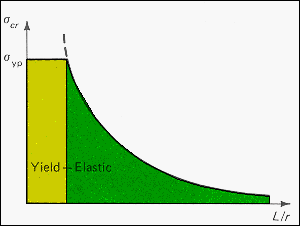| |
The load
at which buckling occurs can be converted into a stress by dividing by the
initial area, A, of the strut. If the rod is circular in cross-section then
A = pr2 and the geometric moment of inertia
I = pr4/4 so that the buckling stress can be written: sCr = p2E/4(L/r)2. For sCr
< sy the strut will buckle before
plastically deforming, the green "Elastic" zone shown on the diagram.
For sCr > sy the strut will plastically deform before
buckling and the yellow "Yield" zone corresponds to this behavior.
The ratio (L/r) is known as the slenderness ratio of the strut. A large
slenderness ratio gives a low buckling stress.
Material selection for
a strut that will have the highest buckling stress for its mass can be based
on normalized properties of the sort that have been discussed for tensile behavior.
The mass of a strut can be written in terms of its density, r, and its
dimensions: m
= rAL. Substituting this into the expression
for the buckling force and collecting the material properties in a "red"
term gives:
(FCr/m2) = (p2/4L4)(E/r2).
For the initial material choice, the group with the largest value of (E/r2) should be selected on the Ln E v. Ln r diagram. |
|
|
|
|
|
|
|
|
|
|
|
|
